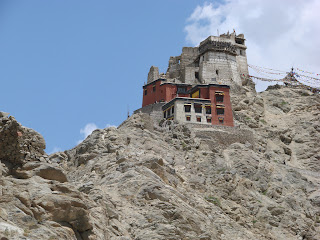HISTORY OF DHOLPUR
Dholpur according to the Epics was initially known as
Dhawalgiri and later on Dhaulagir,and now as Dholpur.
Before the battle of Mahabharat this whole area was
under the Yadavs.Whose different branches were spread
over the entire area extending from the south of the
river Chambal. There is a common belief that some of
the Aryan races also lived in this part. Col. James
Todd in his book ‘Annals and Antiquities of Rajputana’
has mentioned that the area was submerged under sea
during the Ramayan period.
Nihal Singh's successor, Maharaj Rana Ram Singh, proved
something of a wastrel. Early in his term of office, he
incurred the ire of Lord Curzon, for whom he could do no
_thing right. His early death in 1911 probably came as a
relief to the Imperial authorities.Luckily for the state
his younger brother and successor,Maharaj Rana Udai Bhan
Singh,was cast in the same mettle as his forefathers. He
enjoyed wide interests,military,administrative,political
and sporting, which made him the ideal ruler in the eyes
of the British. He maintained close connections with his
fellow rulers,members of the British Royal Family,Viceroys
and administrators alike. He did much to try to bridge the
gap between the growing movement for independence with
those of the traditional rulers and with the British.Sadly
for him, events moved swiftly as a consequence of the
Second World War. He soon accommodated himself to the new
realities and built bridges with Pandit Nehru. After inde
_pendence in 1947, he was instrumental in forming the Matsya
Union a year later. He served as its Rajpramukh, or Head
of State, during the brief period before it merged into the
larger Rajasthan Union in 1949.
At the death of Udai Bhan Singh in 1954, the Maharaj Rana
left no sons and no designated male heir. His widow then
adopted their grandson, the second son of their only daughter
who had married the Maharaja of Nabha. The Indian government
then instituted a lengthy investigation that lasted two years,
but eventually recognised Hemant Singh as Maharaj Rana. Sixteen
years later and after completing his majority, he married the
descendant of the old enemy, Maharajkumari Vasundhara Scindia
of Gwalior. Sadly, they separated within a year of their marriage.
The Maharani went on to build a formidable political career.
She serves today as Chief Minister of Rajasthan.
Dholpur Tourism
Dholpur is a famous holiday destination in the state of
Rajasthan, which is popularly known for Damoye waterfalls
in Sarmathura. Earlier called Dhawalgiri,this place was
later known as Dhaulagir and finally Dholpur.This district
is situated near Bharatpur District and is surrounded by
the state of Uttar Pradesh in the north and Madhya Pradesh
towards south.
Yadavas controlled the entire region till the battle of
Mahabharata concluded. The ancient history of Dholpur is
reflected in the ruins of the fort situated on the banks
of Chambal River. Ruins of Mahabharata period can also be
seen at the ancient temple of Muchukund Ji.Dholpur was also
once part of Matsya Janpada, which formed one of the 16 Maha
Janpadas during Buddha's period. The Matsya Janpada later
became part of the Mauryan Empire.Later on,during Gupta dynasty
it became part of Mathura Janpada.
From 8th century to 10th century, the Janpada was ruled by
Chauhans, after which it came under the reign of Jats. The
town is believed to have earned its name from Raja Dholan
Deo Tonwar, a ruler of this district. The king used to live
at a place called Bilpur, which is situated near Chambal
and features an old fort.
In 1120 AD, the Dholpur Fort was constructed by Dharampal,
who was the Raja of Karauli. During Mughal rule, Dholpur
was a famous tourist spot, which was frequented by royals
for its natural beauty and forests.
The major attractions in and around Dholpur include Talab-e
-Shahi, Machkund Temple, National Chambal Wildlife Sanctuary
and Shergarh Fort. Part of the princely state before Indian
independence, it became a separate district in 1982. The
district comprises four tehsils, namely Baseri, Bari, Dholpur
and Rajakhera.The town of Dholpur is situated between Gwalior
and Agra that are 55 km away from the main town. It is situated
250 km from the national capital Delhi.Dholpur lies on the central
railway route and is connected by National Highway (NH-3) on
Delhi-Mumbai Road. The closest airport from Dholpur is located at
Gwalior, which is around 60 km from the district. Dholpur has its
own railway station, which is connected with trains coming from
Delhi, Amritsar and Jhansi. Tourists can also choose to travel to
the destination by buses from different places, like Gwalior and Agra.
Among all the seasons, the best time to travel to Dholpur is
the winter season, between October and February.
Tourist Places in DHOLPUR recommended by travellers
1. Shergarh Fort
2. Ramsagar Sanctuary
3. Machkund temple
4. Talab-E-Shahi
5. Nihal towe
6. Sher Shikar Gurudwara
7. Ravines of Chambal
8. Van Vihar Wild Life Sanctuary
9. National Chambal (Gharial) Wildlife Sanctuary
10.Damoye waterfal




















.JPG)





























